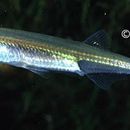pt-BR
nomes no trilho de navegação


The Australian smelt (Retropinna semoni) is a small, pelagic silvery freshwater fish found in large numbers in waters of the south eastern Australian mainland.
The fish is endemic to Australia and widely distributed through the coastal drainages of the south eastern part of the mainland.[2] The species is found in coastal drainages from the south east corner of South Australia through Victoria, New South Wales to the Fitzroy River in south east Queensland. It occurs widely in the Murray River and its tributaries and up the Darling as far upstream as Wilcannia. There are isolated populations in the Coopers Creek which drains into Lake Eyre and several smaller ones in north-western New South Wales and southern Queensland. Recent genetic research indicates Australian smelt stocks are composed of 5 highly genetically distinct and as yet undescribed species (Hammer et al., 2007).
A small silvery fish to 75 mm total length, very occasionally to 100 mm. In Coopers Creek usually only to 50 mm. It is clear to purple-olive on the back, translucent with a silver streak along the sides, sometimes with orange highlights, and has colourless fins. Captively raised specimens will easily exceed 100mm[3] and live for longer periods than their wild counterparts.[2]
Often found in large schools of thousands, this pelagic species prefers slow moving or still waters. It is often found in billabongs, dams and lakes at various salinity levels and in the lower reaches of rivers and streams. Although there have been some reports of diadromous populations, this fish usually completes its entire life cycle in freshwater. They shoal near the surface and around the cover of aquatic plants and woody debris.[2]
A carnivorous fish, the Australian smelt feeds mostly on small invertebrates such as aquatic insects and microcrustaceans, and a variety of planktonic organisms.
Spawns in spring at water temperatures in excess of 15 °C. Eggs are demersal, adhesive, spherical and transparent, about 0.8 mm diameter to 1 mm when water hardened. Eggs fall to the bottom and stick to instream debris, vegetation and the substrate. Females lay between 100 and 1000 eggs. Hatching occurs at about 9 to 10 days and larvae are around 4.5 to 5 mm total length.
This species has some potential as an aquarium species. Ideally suited to use as an effective mosquito predator in ponds in south eastern Australia, especially where frogs are encountered. Not suitable for use in a community tank, best kept as a school of fish in a single species situation.
The Australian smelt (Retropinna semoni) is a small, pelagic silvery freshwater fish found in large numbers in waters of the south eastern Australian mainland.
Retropinna semoni Retropinna generoko animalia da. Arrainen barruko Retropinnidae familian sailkatzen da.
Retropinna semoni Retropinna generoko animalia da. Arrainen barruko Retropinnidae familian sailkatzen da.
Retropinna semoni (l'Éperlan australien) est une espèce de poissons qui se rencontre dans un grand nombre de rivières du sud-est de l'Australie.
C'est un petit poisson argenté de 7,5 cm de long en moyenne, 10 cm pour les plus grands.
Poisson très abondant dans tout le sud-est du continent australien, on le trouve dans toutes les rivières côtières d'Australie-Méridionale, de l'État de Victoria et de Nouvelle-Galles du Sud, jusqu'à la rivière Fitzroy au sud-est du Queensland. Il est très abondant dans le Murray et ses affluents notamment la Darling jusqu'à Wilcannia. On trouve des populations isolées dans la rivière Coopers qui se jette dans le lac Eyre et quelques individus de petite taille au nord-ouest de la Nouvelle Galles du Sud et au sud du Queensland.
Il se nourrit de petits insectes aquatiques, de tout petits crustacés et de plancton.
Il vit souvent en grands bancs, dans les eaux stagnantes ou calmes. On les trouve souvent dans les billabongs, les barrages, les lacs australiens plus ou moins salés et dans la partie basse des cours d'eau. Bien qu'on ait signalé quelques populations diadromes, ces poissons vivent généralement uniquement en eau douce.
Il se reproduit au printemps dans des eaux de température supérieure à 15 °C. La femelle pond entre 100 et 1 000 œufs qui sont fécondés par le mâle. Les œufs transparents, sphériques, de 0,8 à 1 mm de diamètre rassemblés en grappes vont tomber sur le fond et s'accrocher à la végétation, des débris ou sur le sol. Les alevins naissent 9 à 10 jours après la ponte et mesurent 4,5 à 5 mm de long.
Pouvant être utilisé comme poisson d'aquarium pour sa couleur argentée, il est surtout utilisé dans les mares et autres étendues d'eau douce car se nourrissant de larves de moustiques, il permet une démoustification efficace et peu onéreuse.
Retropinna semoni (l'Éperlan australien) est une espèce de poissons qui se rencontre dans un grand nombre de rivières du sud-est de l'Australie.
Retropinna semoni is een straalvinnige vissensoort uit de familie van Nieuw-Zeelandse snoekforellen of smelten (Retropinnidae).[1] De wetenschappelijke naam van de soort is voor het eerst geldig gepubliceerd in 1895 door Weber.
Bronnen, noten en/of referenties西氏後鰭鮭,為輻鰭魚綱胡瓜魚目後鰭鮭科的其中一種,溫帶魚類,分布於西南太平洋澳洲淡水、半鹹水域,體長可達10公分,棲息在沼澤、河川及河口,以昆蟲、甲殼類等為食,會進行洄游,生活習性不明,可做為食用魚。
西氏後鰭鮭,為輻鰭魚綱胡瓜魚目後鰭鮭科的其中一種,溫帶魚類,分布於西南太平洋澳洲淡水、半鹹水域,體長可達10公分,棲息在沼澤、河川及河口,以昆蟲、甲殼類等為食,會進行洄游,生活習性不明,可做為食用魚。